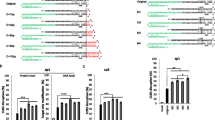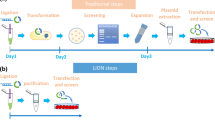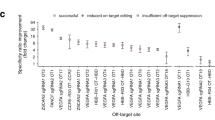Abstract
The CRISPR/Cas9 technique has emerged as a powerful and promising tool for precise genomic integration, which applied to various cell types and organisms, but its efficiency largely depends on single-guide RNA (sgRNA). There are multiple strategies available to evaluate the cleavage activity of sgRNAs, and one such approach is T7 endonuclease I (T7EI) assay, which is laborious and time consuming, especially when one must address multiple samples in parallel. In this study, a simple and rapid method to detect the cleavage activity of sgRNA was developed. Based on the single-strand annealing (SSA) repair mechanism, a surrogate reporter system using firefly luciferase was constructed to evaluate the targeting efficiency of sgRNAs. Using this system, the luciferase activities of eight sgRNAs were observed, and one of them had highest cutting efficiency (p < 0.01). Thereby, T7EI assay was compared with the method established in this study to determine the accuracy and sensitivity, and the results of these two methods were consistent suggesting that the SSA reporter system was compatible with T7EI assay. Compared with T7EI assay requiring multiple steps, such as PCR amplification, the SSA reporter system with one-step transfection can be completed on a large scale of sgRNAs within approximate two days. These findings suggested that SSA-based reporter system can accurately and rapidly evaluate the cleavage activities of multiple sgRNAs, thereby providing a robust and reliable process for CRISPR/Cas9 to select sgRNAs efficiently in genome editing.



Similar content being viewed by others
REFERENCES
Durai S., Mani M., Kandavelou K., Wu J., Porteus M.H., Chandrasegaran S. 2005. Zinc finger nucleases: Custom-designed molecular scissors for genome engineering of plant and mammalian cells. Nucleic Acids Res. 33, 5978‒5990.
Christian M., Cermak T., Doyle E.L., Schmidt C., Zhang F., Hummel A., Bogdanove A.J., Voytas D.F. 2010. Targeting DNA double-strand breaks with TAL effector nucleases. Genetics. 186, 757‒761.
Cong L., Ran F.A., Cox D., Lin S.L., Barretto R., Habib N., Hsu P.D., Wu X.B., Jiang W.Y., Marraffini L.A., Zhang F. 2013. Multiplex genome engineering using CRISPR/Cas systems. Science. 339, 819‒823.
Carroll D. 2014. Genome engineering with targetable nucleases. Annu. Rev. Biochem. 83, 409‒439.
Cathomen T., Joung J.K. 2008. Zinc-finger nucleases: The next generation emerges. Am. Soc. Gene Ther. 16, 1200‒1207.
Pennisi E. 2012. The tale of the TALEs. Science. 338, 1408‒1411.
Jinek M., Chylinski K., Fonfara I., Hauer M., Doudna J.A., Charpentier E. 2012. A programmable dual-RNA-guided DNA endonuclease in adaptive bacterial immunity. Science. 337, 816‒821.
Mali P., Yang L., Esvelt K.M., Aach J., Guell M., DiCarlo J.E., Norville J.E., Church G.M. 2013. RNA-guided human genome engineering via Cas9. Science. 339, 823‒826.
Hwang W.Y., Fu Y., Reyon D., Maeder M.L., Tsai S.Q., Sander J.D., Peterson R.T., Yeh J.R., Joung J.K. 2013. Efficient genome editing in zebrafish using a CRISPR-Cas system. Nat. Biotechnol. 31, 227‒229.
Gratz S.J., Cummings A.M., Nguyen J.N., Hamm D.C., Donohue L.K., Harrison M.M., Wildonger J., O’Connor-Giles K.M. 2013. Genome engineering of Drosophila with the CRISPR RNA-guided Cas9 nuclease. Genetics. 194, 1029‒1035.
Cho S.W., Kim S., Kim J.M., Kim J.S. 2013. Targeted genome engineering in human cells with the Cas9 RNA-guided endonuclease. Nat. Biotechnol. 31, 230‒232.
Wang H., Yang H., Shivalila C.S., Dawlaty M.M., Cheng A.W., Zhang F., Jaenisch R. 2013. One-step generation of mice carrying mutations in multiple genes by CRISPR/Cas-mediated genome engineering. Cell. 153, 910‒918.
Doench J.G., Fusi N., Sullender M., Hegde M., Vaimberg E.W., Donovan K.F., Smith I., Tothova Z., Wilen C., Orchard R., Virgin H.W., Listgarten J., Root D.E. 2016. Optimized sgRNA design to maximize activity and minimize off-target effects of CRISPR-Cas9. Nat. Biotechnol. 34, 184‒191.
Chuai G., Ma H., Yan J., Chen M., Hong N., Xue D., Zhou C., Zhu C., Chen K., Duan B., Gu F., Qu S., Huang D., Wei J., Liu Q. 2018. DeepCRISPR: Optimized CRISPR guide RNA design by deep learning. Genome Biol. 19, 80.
Rahman M.K., Rahman M.S. 2017. CRISPRpred: A flexible and efficient tool for sgRNAs on-target activity prediction in CRISPR/Cas9 systems. PLoS One. 12, e0181943.
Smurnyy Y., Cai M., Wu H., McWhinnie E., Tallarico J.A., Yang Y., Feng Y. 2014. DNA sequencing and CRISPR-Cas9 gene editing for target validation in mammalian cells. Nat. Chem. Biol. 10, 623‒625.
Liu X., Wang Y.S., Guo W.J., Chang B.H., Liu J., Guo Z.K., Quan F.S., Zhang Y. 2013. Zinc-finger nickase-mediated insertion of the lysostaphin gene into the beta-casein locus in cloned cows. Nat. Commun. 4, 2565.
Gross T., Jeney C., Halm D., Finkenzeller G., Stark G.B., Zengerle R., Koltay P., Zimmermann S. 2021. Characterization of CRISPR/Cas9 RANKL knockout mesenchymal stem cell clones based on single-cell printing technology and emulsion coupling assay as a low-cellularity workflow for single-cell cloning. PLoS One. 16, e0238330.
Sentmanat M.F., Peters S.T., Florian C.P., Connelly J.P., Pruett-Miller S.M. 2018. A survey of validation strategies for CRISPR-Cas9 editing. Sci. Rep. 8, 888.
Lee J.M., Kim U., Yang H., Ryu B., Kim J., Sakuma T., Yamamoto T., Park J.H. 2021. TALEN-mediated generation of Nkx3.1 knockout rat model. Prostate. 81, 182‒193.
Jia C., Huai C., Ding J., Hu L., Su B., Chen H., Lu D. 2018. New applications of CRISPR/Cas9 system on mutant DNA detection. Gene. 641, 55‒62.
Kim H., Um E., Cho S.R., Jung C., Kim H., Kim J.S. 2011. Surrogate reporters for enrichment of cells with nuclease-induced mutations. Nat. Methods. 8, 941‒943.
Mashal R.D., Koontz J., Sklar J. 1995. Detection of mutations by cleavage of DNA heteroduplexes with bacteriophage resolvases. Nat. Genet. 9, 177‒183.
He Z., Shi X., Liu M., Sun G., Proudfoot C., Whitelaw C.B., Lillico S.G., Chen Y. 2016. Comparison of surrogate reporter systems for enrichment of cells with mutations induced by genome editors. J. Biotechnol. 221, 49‒54.
Vouillot L., Thelie A., Pollet N. 2015. Comparison of T7E1 and surveyor mismatch cleavage assays to detect mutations triggered by engineered nucleases. G3 (Bethesda). 5, 407‒415.
Labuhn M., Adams FF., Ng M., Knoess S., Schambach A., Charpentier E.M., Schwarzer A., Mateo J.L., Klusmann J.H., Heckl D. 2018. Refined sgRNA efficacy prediction improves large- and small-scale CRIS-PR-Cas9 applications. Nucleic Acids Res. 46, 1375‒1385.
Ren C., Xu K., Liu Z., Shen J., Han F., Chen Z., Zhang Z. 2015. Dual-reporter surrogate systems for efficient enrichment of genetically modified cells. Cell. Mol. Life Sci. 72, 2763‒2772.
Yan N., Sun Y., Fang Y., Deng J., Mu L., Xu K., Mymryk J.S., Zhang Z. 2020. A universal surrogate reporter for efficient enrichment of CRISPR/Cas9-mediated homology-directed repair in mammalian cells. Mol. Ther. Nucleic Acids. 19, 775‒789.
Kim Y.H., Ramakrishna S., Kim H., Kim J.S. 2014. Enrichment of cells with TALEN-induced mutations using surrogate reporters. Methods. 69, 108‒117.
Mali P., Esvelt K.M., Church G.M. 2013. Cas9 as a versatile tool for engineering biology. Nat. Methods. 10, 957‒963.
Fu Y., Sander J.D., Reyon D., Cascio V.M., Joung J.K. 2014. Improving CRISPR-Cas nuclease specificity using truncated guide RNAs. Nat. Biotechnol. 32, 279‒284.
Perez E.E., Wang J.B., Miller J.C., Jouvenot Y., Kim K.A., Liu O., Wang N., Lee G., Bartsevich V.V., Lee Y.L., Guschin D.Y., Rupniewski I., Waite A.J., Carpenito C., Carroll R.G., Orange J.S., Urnov F.D., Rebar E.J., Ando D., Gregory P.D., Riley J.L., Holmes M.C., June C.H. 2008. Establishment of HIV-1 resistance in CD4(+) T cells by genome editing using zinc-finger nucleases. Nat. Biotechnol. 26, 808‒816.
Kim H.J., Lee H.J., Kim H., Cho S.W., Kim J.S. 2009. Targeted genome editing in human cells with zinc finger nucleases constructed via modular assembly. Genome Res. 19, 1279‒1288.
Lee H.J., Kim E., Kim J.S. 2010. Targeted chromosomal deletions in human cells using zinc finger nucleases. Genome Res. 20, 81‒89.
Ramakrishna S., Cho S.W., Kim S., Song M., Gopalappa R., Kim J.S., Kim H. 2014. Surrogate reporter-based enrichment of cells containing RNA-guided Cas9 nuclease-induced mutations. Nat. Commun. 5, 3378.
Rulten S.L., Grundy G.J. 2017. Non-homologous end joining: Common interaction sites and exchange of multiple factors in the DNA repair process. Bioessays. 39 (3). https://doi.org/10.1002/bies.201600209
Wilson K.A., Chateau M.L., Porteus M.H. 2013. Design and development of artificial zinc finger transcription factors and zinc finger nucleases to the hTERT locus. Mol. Ther. Nucleic Acids. 2, e87.
Preston C.R., Flores C.C., Engels W.R. 2006. Differential usage of alternative pathways of double-strand break repair in Drosophila. Genetics. 172, 1055‒1068.
Mon H., Kusakabe T., Bando H., Kojima K., Kawaguchi Y., Koga K. 2003. Analysis of extrachromosomal homologous recombination in cultured silkworm cells. Biochem. Biophys. Res. Commun. 312, 684‒690.
Al-Zain A.M., Symington L.S. 2021. The dark side of homology-directed repair. DNA Repair (Amst.). 106, 103181.
Kuhar R., Gwiazda K.S., Humbert O., Mandt T., Pangallo J., Brault M., Khan I., Maizels N., Rawlings D.J., Scharenberg A.M., Certo M.T. 2014. Novel fluorescent genome editing reporters for monitoring DNA repair pathway utilization at endonuclease-induced breaks. Nucleic Acids Res. 42, e4.
Liskay R.M., Letsou A., Stachelek J.L. 1987. Homology requirement for efficient gene conversion between duplicated chromosomal sequences in mammalian cells. Genetics. 115, 161‒167.
Dong C., Gou Y., Lian J. 2022. SgRNA engineering for improved genome editing and expanded functional assays. Curr. Opin. Biotechnol. 75, 102697.
Hiranniramol K., Chen Y., Liu W., Wang X. 2020. Generalizable sgRNA design for improved CR-ISPR/Cas9 editing efficiency. Bioinformatics. 36, 2684‒2689.
Szczepek M., Brondani V., Buchel J., Serrano L., Segal D.J., Cathomen T. 2007. Structure-based redesign of the dimerization interface reduces the toxicity of zinc-finger nucleases. Nat. Biotechnol. 25, 786‒793.
Zou J., Maeder M.L., Mali P., Pruett-Miller S.M., Thibodeau-Beganny S., Chou B.K., Chen G., Ye Z., Park I.H., Daley G.Q., Porteus M.H., Joung J.K., Cheng L. 2009. Gene targeting of a disease-related gene in human induced pluripotent stem and embryonic stem cells. Cell Stem Cell. 5, 97‒110.
Xiao A., Cheng Z., Kong L., Zhu Z., Lin S., Gao G., Zhang B. 2014. CasOT: A genome-wide Cas9/gRNA off-target searching tool. Bioinformatics. 30, 1180‒1182.
Zhang H.M., Zhou Y.X., Wang Y.A., Zhao Y.G., Qiu Y.T., Zhang X.Y., Yue D., Zhou Z., Wei W.S. 2018. A surrogate reporter system for multiplexable evaluation of CRISPR/Cas9 in targeted mutagenesis. Sci. Rep. 8 (1), 1042.
ACKNOWLEDGMENTS
We would like to thank Dr. Jian Kang, Dr. Deji Luan and Dr. Kang Zhang for the suggestions in performing experiments.
Funding
This work was supported by National Major Project for Production of Transgenic Breeding (no. 2016ZX08007-002) and National Natural Science Foundation of China (no. 31873033).
Author information
Authors and Affiliations
Contributions
PD and XCD contributed equally to this work. PD and XCD have made substantial contributions to conception, acquisition of data, drafting the manuscript; XYW have made substantial contributions to analysis and interpretation of data; YPG and FSQ have given final approval of the version to be published. All authors of this article agree to be accountable for all aspects of the work.
Corresponding authors
Ethics declarations
CONFLICT OF INTEREST
The authors of this work declare that they have no conflicts of interest.
MATERIALS AVAILABILITY
The data used to support the findings of this study are included within the article. The data and materials in the current study are available from the corresponding author on reasonable request.
ETHICS APPROVAL AND CONSENT TO PARTICIPATE
This work does not contain any studies involving human and animal subjects.
Additional information
Publisher’s Note.
Pleiades Publishing remains neutral with regard to jurisdictional claims in published maps and institutional affiliations.
Supplementary Information
Rights and permissions
About this article
Cite this article
Deng, P., Dong, X.C., Wang, X.Y. et al. Verification of CRISPR/Cas9 Activity In Vitro via SSA-Based Dual-Luciferase Reporter System. Mol Biol (2024). https://doi.org/10.1134/S0026893324700092
Received:
Revised:
Accepted:
Published:
DOI: https://doi.org/10.1134/S0026893324700092




